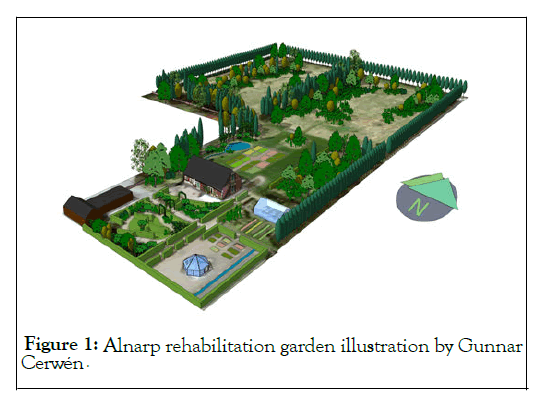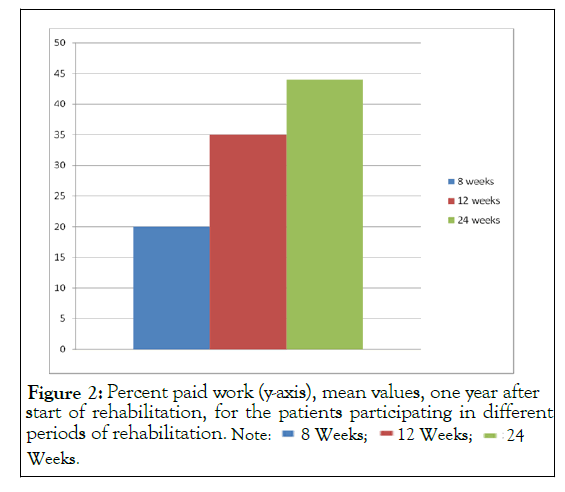International Journal of Physical Medicine & Rehabilitation
Open Access
ISSN: 2329-9096
ISSN: 2329-9096
Review Article - (2021)Volume 9, Issue 6
Background: Stress-related mental illness is increasing worldwide and leading to long-term illness. Most of those affected are aged 30-50, so the need for rehabilitation and return to work for these patients is great. Research indicates that staying in nature can lead to stress recovery. The question is whether nature-based therapy can rehabilitate people who suffer from long-term stress-related mental illness, and how long a period of rehabilitation is necessary.
Methods and findings: The research was carried out at Alnarp Rehabilitation Garden, which is a specially designed health garden on the Swedish University of Agricultural Sciences’ campus area, where the participants in the study were treated by a licensed rehabilitation team. The intention was to examine three cohorts of participants prospectively. These were offered different lengths of a nature-based rehabilitation program through a natural experiment. Participants were referred to Alnarp Rehabilitation Garden from three local social insurance agencies that granted different lengths of rehabilitation programs: 8 weeks, 12 weeks and 24 weeks. The length of the program was determined by which local social insurance agencies they belonged to, not the participants' level of illness. Primary outcome was return to work. Other outcomes were occupational function, personal control and sense of coherence. The results showed that all three rehabilitation interventions gave significantly good results, but that longer nature-based rehabilitation led to significantly better results for all outcomes. The 12-week program provided 75% greater return to paid work and the 24-week program 120% greater return to paid work than the 8-week program.
Conclusion: There is a significant positive relationship between treatment time in the rehabilitation garden and return to work. The study also indicates that the effects may level off after twelve weeks. More studies are needed to further investigate the relationships.
Supportive environments; Perceived sensory dimensions; Alnarp rehabilitation garden; Green care; Horticultural therapy
The global burden of mental disorders is considerable, and depression is ranked by WHO as the single largest contributor to global disability [1,2]. In Sweden, mental illness is the most common cause of long-term sick leave, which means more than 90 days of sick leave. In four out of five long-term cases of mental diagnosis (e.g. exhaustion disorder/burnout or depression) they are due to a reaction to severe stress [3]. Psychosocial factors at work are believed to be one main contributor to this escalation [4]. Consequently, knowledge with regard to rehabilitation of stress-related mental health problems is urgent.
There is growing scientific evidence that natural environments can relieve symptoms of stress [5]. Nature-based therapy may therefore be suitable for people who are on sick leave from work due to stress-related mental illness.
There is a long tradition of using nature-based therapy in healthcare, and since the end of the 1990s research in this area has gradually increased, especially regarding patients with mental disorders. Extensive reviews [6] conclude that naturebased therapy can lead to improvements related to different diagnoses. The effect size is highest for diagnoses related to mild to moderate mental illness.
At the Swedish University of Agricultural Sciences in Alnarp, a rehabilitation garden has been built on the campus area, located outside Malmö in the southernmost part of Sweden. It is part of the university's research infrastructure and is used for research, teaching and innovation.
The garden has been built based on the Supportive Environment Theory (SET), a biopsychosocial theory based on the assumption that humans have evolved to adapt to a life close to nature and with a social and cultural interaction with a limited number of people [7].
Supportive environments consist of physical (e.g. natural and built environments), social (e.g. friends, colleagues and family) and cultural environments (e.g. work and leisure). SET argues that people need supportive environments to develop, maintain health and heal; physically (e.g. senses, muscles and movement) and mentally (e.g. ability to feel, think and cope) [7,8], asserts that multimodal therapy should be based on the fact that people register the environment via several modalities and are strongly influenced by them.
People can thus also be treated successfully via several modalities, such as different sensory impressions and by way of social communication. Nature-based therapy according to SET is therefore designed to offer a supportive physical environment (specially selected or specially designed), supportive activities and a supportive social environment, where the intervention is performed by a multimodal team [9-11].
Research at SLU in Alnarp has identified eight basic Perceived Sensory Dimensions (PSDs) in garden and nature areas. Together, these eight dimensions could define a spectrum of multisensory experiences, of sight, hearing, smell, taste, touch, temperature, proprioception and balance, which could offer good conditions for a multimodal treatment (Stoltz and Grahn, 2021). Alnarp Rehabilitation Garden was designed to contain all eight PSDs [9]. The garden also contains a gradient from destressing and relaxing parts for rest and contemplation to active and challenging parts, with cultivation and social activities (Figure 1).

Figure 1: Alnarp rehabilitation garden illustration by Gunnar Cerwén.
The supportive environment theory states that a sufficiently long stay in a supportive environment, with a multimodal team, is required for physical and mental healing to take place, and to increase coping strategies. If the stay is too short, the effect will not be sufficient. The main purpose and primary endpoint of this study was to examine the relationship between time in a rehabilitation garden and return to work. Secondary endpoints were self-assessed function, personal control and sense of coherence.
An agreement was reached between the Swedish University of Agricultural Sciences and the Swedish Social Insurance Agency regarding the referral of long-term sick with the diagnoses depression (ICD-10 F32·0 or F32·1) and exhaustion disorder (ICD-10 F43·8 or F43·9) to Alnarp Rehabilitation Garden. The selection was made through a natural experiment [12], with three cohorts from three local offices of the Swedish Social Insurance Agency, having different agreements. These agreements entailed 8, 12 or 24 weeks of rehabilitation in Alnarp Rehabilitation Garden. This meant that three cohorts, with a total of 106 patients, were prospectively followed over three different periods: Eight weeks (n=44); Twelve weeks (n=48) and 24 weeks (n=14). No participants exited the intervention. The three cohorts were very similar in terms of age, gender, socio-economic status, time they had been on sick leave and diagnosis. In all three groups, the participants had been on sick leave for almost four years and during that time they had not been able to work at all. The ratio between the number of people on sick leave for exhaustion disorder and depression was about 2 to 1. Gardening and horticulture activities also included resting and walking in the garden. Depending on the participant's physical and mental condition, the more workrelated activities gradually increased. Individual physical therapy and psychotherapy were provided to participants on Tuesday and Wednesday. When possible, physical therapy was performed in the garden. The only difference between the groups was the number of weeks they participated in the nature-based intervention program at Alnarp Rehabilitation Garden.
Return to work data were collected before the intervention and one year after. In addition, data were collected regarding selfassessed occupational capability (the Occupational Self- Assessment protocol), personal control (the Mastery Scale), and sense of coherence (the Sense of Coherence-29). As many as 68% of all participants returned to work or participated in job training or work-oriented measures, full or part-time, after one year. Participants with a longer period (i.e., 12 or 24 weeks) of rehabilitation reported higher scores on occupational capacity, and were more likely to participate in paid work, full-time or part-time, one year after rehabilitation (Figure 2).

Figure 2: Percent paid work (y-axis), mean values, one year after start of rehabilitation, for the patients participating in different periods of rehabilitation Note:  Weeks.
Weeks.
Study outcomes show that a longer rehabilitation period increases the possibility of a return to paid work. Staying outdoors in a garden means several health benefits, such as access to daylight, receiving UVB radiation from the sun that results in the production of vitamin D in the body and physical activity that can support the patient´s recovery process [13].
In addition, studies of participants' activities in the garden show great advantages of having access to a garden with many qualities and where there is a gradient in several steps between rest and stress recovery, to physical activities and social challenges [14,11]. The start of the rehabilitation period is important; that the participant can find a place where he or she can feel safe and serenity [15]. If so, the participant can get access to sensory experiences of soft impressions, of the sun's heat in the face, the whiz of the wind in the vegetation, the scent of flowers and more. Studies show that Alnarp Rehabilitation Garden provides in depth sensory experiences of several different kinds, supporting the recovery process [15-17]. Presumably, the parasympathetic system can be activated when in safe garden environments with soft and pleasant sensory impressions, and thus healing can be accelerated. Once security has emerged, the participant can begin to interact with the physical environment and thereby increase their ability. However, this occurs in stages and takes time [7,9,15].
The study was not randomized, however, randomized controlled trial design is challenging to use in rehabilitation research [18]. Other strategies can provide equally safe or safer results: Smaller natural experiments with a stronger focus on individual participants can be a good research strategy for developing evidence-based solutions in rehabilitation research. Among other things, ethical problems are reduced, and the result gives a fairer picture of what real rehabilitation looks like [12,19,20].
The primary goal of this study was to look at return to work one year after beginning participation in nature-based rehabilitation programmes of varying lengths. Our main hypothesis, which is based on the Supportive Environment Theory (SET), states that a longer nature-based rehabilitation programme would improve the ability to return to work. This would be due to increases in occupational competence, personal control, and sense of coherence. These findings suggest that the length of the rehabilitation period does matter in a dose-response manner, and that eight weeks of therapy may be insufficient for the majority of participants, which is consistent with SET.
There is a positive correlation between the time spent in the rehabilitation garden and return to work. Data suggest that if patients are allowed to stay for a longer period in supportive environments, in the form of a physical, social, and cultural environment with a therapeutic team, it leads to clinically meaningful improvements, resulting in a higher return to work. However, it is worth mentioning that the outcomes are the results of a unique combination of a designed health garden and a licensed rehabilitation team joined in nature-based health intervention. It is the time in such a garden that has been examined. Furthermore, the study indicates that the effects may level off after twelve weeks. More studies are needed to investigate this further.
Citation: Grahn P, Palsdottir M (2021) Does More Time in a Therapeutic Garden Lead to a Faster Return to Work? A Prospective Cohort Study of Nature-Based Therapy, Exploring the Relationship between Dose and Response in the Rehabilitation of Long-Term Patients Suffering from Stress- Related Mental Illness. Int J Phys Med Rehabil. 9: 614.
Received: 11-Oct-2021 Accepted: 25-Oct-2021 Published: 01-Nov-2021
Copyright: © 2021 Grahn P, et al. This is an open-access article distributed under the terms of the Creative Commons Attribution License, which permits unrestricted use, distribution, and reproduction in any medium, provided the original author and source are credited.